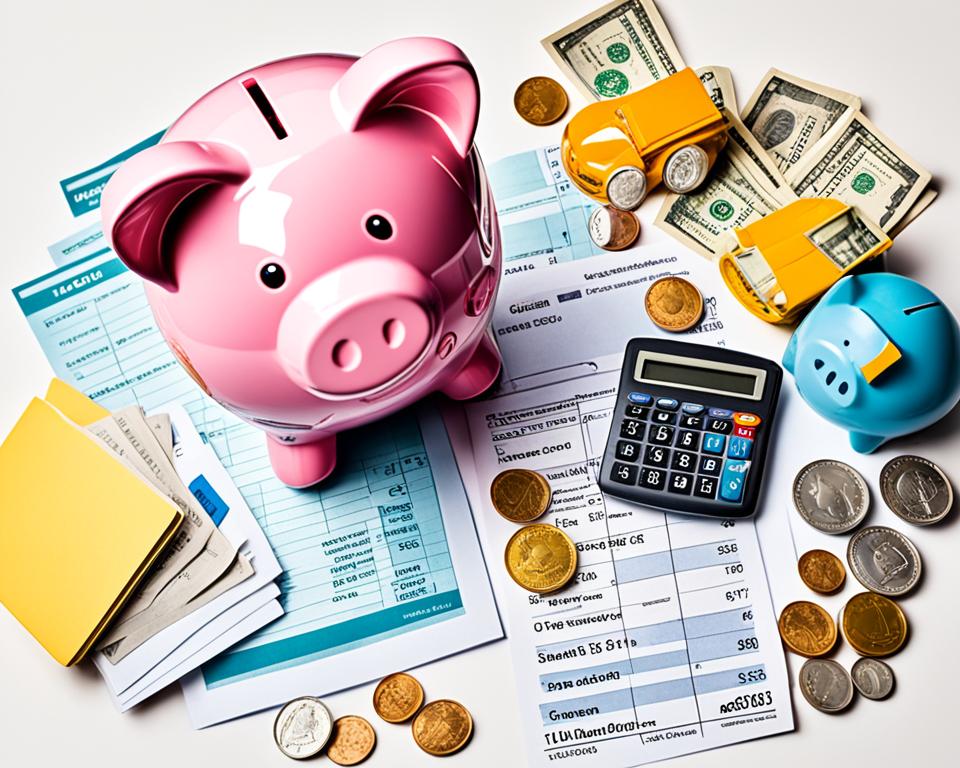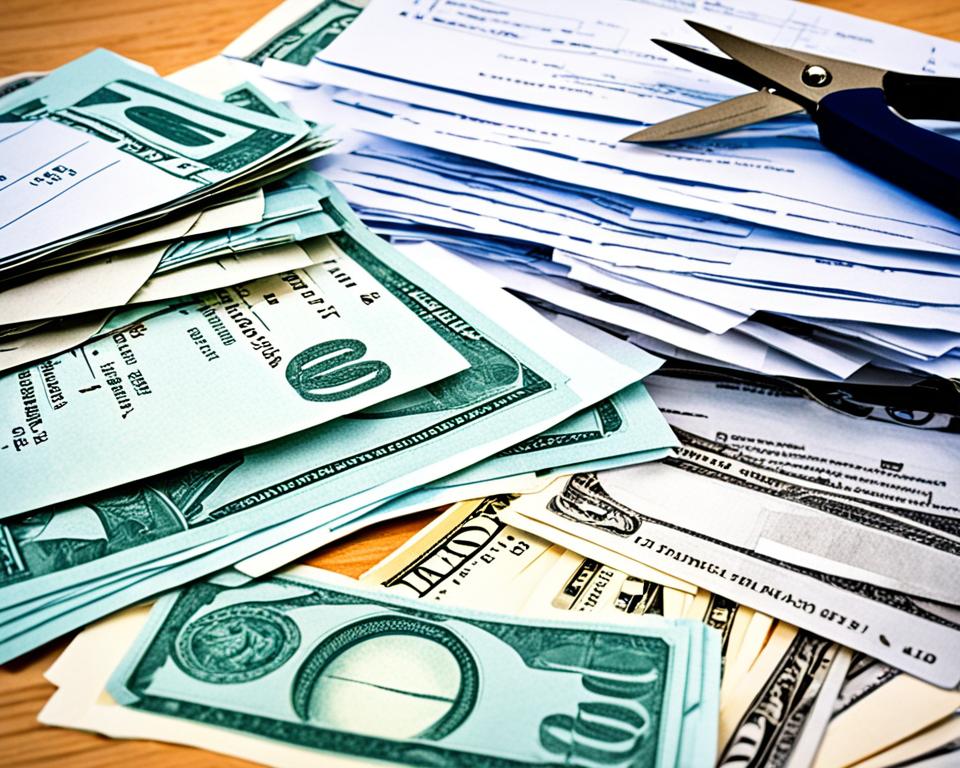Hello there! If you’re looking for ways to effectively manage and reduce your loan debt, you’ve come to the right place. In today’s world, many people are burdened with various types of loans, such as student loans, credit card debt, and personal loans. It’s essential to take control of your financial situation and develop a plan to tackle your debts head-on.
When it comes to managing and reducing loan debt, there are several strategies and options available. From loan repayment strategies to debt consolidation options and even student loan forgiveness programs, you have the power to regain financial stability and reduce your debt load.
Are you ready to take charge of your financial future? In this article, I will guide you through the steps you can take to effectively manage and reduce your loan debt. Let’s get started!
Key Takeaways:
- Assess your outstanding debts and check your credit report for accuracy.
- Consider debt consolidation options to lower your interest rates.
- Be honest about your spending habits and create a budget that includes debt repayment.
- Determine your monthly payment amount and allocate extra funds for debt reduction.
- Choose a debt-reduction strategy that aligns with your financial goals.
Make a list of your outstanding debts
When it comes to effectively managing your loan debt, the first step is to make a comprehensive list of all your outstanding debts. This list will serve as a roadmap for your debt-repayment journey, allowing you to prioritize and tackle each debt strategically.
By organizing your debts in a list, you gain a clear understanding of your overall financial obligations, enabling you to make informed decisions on how to allocate your resources for debt reduction.
To create your debt list, gather information on each debt you owe, including the outstanding balance, minimum monthly payment, and most importantly, the interest rate associated with each debt. This will allow you to identify the debts that are accruing the highest interest and costing you the most in the long run.
To illustrate the importance of making a debt list, take a look at this example:
| Debt | Outstanding Balance | Minimum Monthly Payment | Interest Rate |
|---|---|---|---|
| Credit Card A | $5,000 | $150 | 18% |
| Credit Card B | $2,500 | $75 | 12% |
| Student Loan | $20,000 | $300 | 6% |
| Car Loan | $15,000 | $250 | 5% |
In this example, by creating a debt list, you can easily identify that Credit Card A, with its 18% interest rate, should be a priority for debt reduction. While it may not have the highest outstanding balance, its higher interest rate means that you’re accumulating more interest over time.
Remember, making a list of your outstanding debts is a critical first step towards effective debt management. It allows you to prioritize your debts based on interest rates, enabling you to save money in the long run by strategically reducing the debts with the highest interest rates.
Next, we’ll explore the importance of checking your credit report to ensure accuracy and identify any potential discrepancies.
Check your credit report
One crucial step in effectively managing your loan debt is to regularly check and review your credit report. By obtaining a free copy of your credit report from one or more of the three major credit reporting agencies, you can gain valuable insights into your financial standing.
Reviewing your credit report allows you to:
- Ensure the accuracy of the information: Check for any errors or inaccuracies in your credit report, such as incorrect account balances or unrecognized accounts. This is crucial as these errors can negatively impact your credit score.
- Identify outstanding debts: It’s important to make sure you haven’t forgotten about any outstanding debts that may not be on your radar. Reviewing your credit report helps you identify any unpaid or overdue debts that require attention.
- Evaluate your creditworthiness: Your credit report provides a summary of your credit history, including your credit score. Checking your credit score allows you to understand how lenders perceive your ability to manage debt and make timely payments.
How to obtain your credit report
To request your credit report, you can visit the websites of the three major credit reporting agencies:
- Equifax
- TransUnion
- Experian
On their websites, you’ll find easy-to-follow instructions on how to obtain your free credit report. Remember to check your credit report regularly, as it’s crucial for staying informed about your financial health and ensuring the accuracy of the information.
“Reviewing your credit report helps you identify any unpaid or overdue debts that require attention.”
In addition to checking your credit report, it’s also a good idea to monitor your credit score regularly. Your credit score is a numerical representation of your creditworthiness and plays a significant role in determining your ability to secure loans and favorable interest rates.
By regularly reviewing your credit report and staying informed about your credit score, you can take proactive steps to improve your creditworthiness, address any outstanding debts, and work towards effective debt management.
| Credit Reporting Agency | Website |
|---|---|
| Equifax | https://www.equifax.com/ |
| TransUnion | https://www.transunion.com/ |
| Experian | https://www.experian.com/ |
Look for opportunities to consolidate
If you have multiple high-interest loans, consolidating them into one loan with a lower interest rate can be a smart financial move. Consolidation allows you to combine your debts into a single, manageable payment, potentially reducing your monthly payments and saving you money in interest charges.
One option for consolidation is taking out a personal loan with a lower interest rate to pay off high-interest credit card balances. This can help you save on interest and simplify your debt by having just one loan to focus on.
However, if you’re considering consolidating your student loans, it’s important to review your eligibility for federal loan forgiveness programs. Consolidating federal student loans may impact your eligibility for certain forgiveness programs, such as Public Service Loan Forgiveness or Teacher Loan Forgiveness. Make sure to evaluate the potential impact on your loan forgiveness options before making a decision.
“Consolidating my loans was a game-changer for my financial situation. I was able to lower my interest rate and reduce my monthly payments, which helped me stay on top of my debt. It’s definitely worth exploring if you’re looking for ways to make your loans more manageable.”
– Sarah Thompson
Be honest about your spending
When it comes to effectively managing and reducing debt, it’s important to take an honest look at your monthly spending habits. By identifying areas where you can cut back or eliminate expenses, you can make significant progress in reducing your debt and avoiding additional financial burdens.
Start by reviewing your budget and analyzing your spending patterns. Take note of recurring expenses, such as subscriptions or dining out, and evaluate their necessity. Consider if there are more cost-effective alternatives or if you can do without certain expenses altogether.
One effective strategy is to create a detailed breakdown of your spending using a budgeting tool or app. This allows you to visualize where your money is going and identify areas where you can make adjustments. By actively tracking your expenses, you’ll gain a clear understanding of your spending habits and can make informed decisions about how to reduce them.
It’s also important to prioritize your spending based on your financial goals. Determine what expenses are essential and align with your priorities, and make budget cuts in areas that are less important or can be temporarily reduced.
Changing spending habits can be challenging, but it’s worth the effort when it comes to achieving your debt reduction goals. Remember, every dollar you save by cutting unnecessary expenses can be put towards paying off debt and improving your financial well-being.
Quotables:
“Identify areas where you can cut back or eliminate expenses to make significant progress in reducing your debt and avoiding additional financial burdens.”
“Create a detailed breakdown of your spending to visualize where your money is going and identify areas where you can make adjustments.”
Spending Habits Table:
| Expense Category | Monthly Amount |
|---|---|
| Housing | $1,200 |
| Transportation | $400 |
| Groceries | $300 |
| Entertainment | $200 |
| Utilities | $150 |
| Subscriptions | $100 |
| Dining Out | $150 |
By analyzing your monthly spending habits and making conscious choices to reduce expenses, you can free up additional funds to put towards debt reduction. Remember, every dollar counts, and small changes in your spending habits can have a significant impact on your financial future.

Determine your monthly payment amount
Once you’ve consolidated your debts, it’s important to determine the amount you need to pay each month. This will help you stay on track and make consistent progress towards reducing your loan debt. To calculate your monthly payment amount, take note of the minimum payments required for each loan and include that total in your budget.
Having a clear understanding of your monthly repayment obligations will give you a realistic overview of your financial situation. It will enable you to plan your budget effectively and allocate the necessary funds towards debt repayment.
If you find that the monthly payment amount is more than you can afford, don’t panic. There are options available to help you manage your loan payments. One option is to contact your lenders and explore the possibility of arranging different payment terms.
By reaching out to your lenders, you may be able to negotiate lower monthly payments, extend the terms of your loan, or request a temporary forbearance or deferment. These alternatives can provide you with the breathing room you need to comfortably make your payments without straining your finances.
Remember, lenders want to help you fulfill your financial obligations, so don’t hesitate to contact them. Most lenders are willing to work with borrowers who are proactive and demonstrate a sincere willingness to repay their debts.
Possible options when contacting lenders
| Option | Description |
|---|---|
| Lower monthly payments | Negotiate with the lender for reduced monthly payment amounts. |
| Loan term extension | Extend the repayment period, resulting in lower monthly payments. |
| Temporary forbearance | Pause or reduce loan payments for a specified period of time. |
| Deferment | Temporarily postpone repayment, often due to financial hardship or enrollment in school. |
Exploring these options with your lenders can help alleviate any financial strain and ensure that your loan payments remain manageable. However, it’s essential to remember that modifying your loan terms may have long-term implications, such as increased interest or extended repayment periods, so carefully assess the potential impact before making any decisions.
By determining your monthly payment amount and contacting your lenders to explore alternative payment terms, you can create a more sustainable repayment plan that fits your financial situation.
Figure out your extra budget for debt reduction
Once you have determined your required monthly payment amount towards debt reduction, it’s time to figure out how much extra money you can allocate towards your debt reduction goal. This involves budgeting and making necessary adjustments to your expenses to free up discretionary money that can be used to make additional payments towards reducing your debt.
Start by reviewing your current budget and identifying areas where you can cut back or eliminate expenses. This could include reducing non-essential spending such as eating out, entertainment, or subscription services. By making small changes in your spending habits, you can save significant amounts of money each month.
Consider creating a detailed budgeting plan, assigning specific amounts to different expense categories and tracking your spending closely. This will help you stay disciplined and accountable to your debt reduction goal.
For example, you might find that you can save $100 per month by cutting back on dining out and $50 by reducing your entertainment expenses. These savings can be redirected towards your debt reduction efforts, providing you with extra funds to make larger payments and accelerate your progress.
Remember, the more discretionary money you can allocate towards debt reduction, the faster you will be able to achieve your goal. By being proactive and intentional with your budgeting, you can take control of your financial situation and work towards becoming debt-free.
“By being proactive and intentional with your budgeting, you can take control of your financial situation and work towards becoming debt-free.”
Example Budgeting Plan
| Expense Category | Monthly Allocation |
|---|---|
| Housing | $800 |
| Transportation | $300 |
| Groceries | $200 |
| Utilities | $150 |
| Debt Payments (Minimum) | $500 |
| Discretionary Expenses | $250 |
| Total Expenses | $2,200 |
In the example budgeting plan above, the person has allocated $250 towards discretionary expenses. However, by cutting back on non-essential spending, they could potentially increase this amount and allocate more towards debt reduction. This could be achieved by reducing discretionary expenses to $200, resulting in an extra $50 each month that can be put towards paying down debt.
Determine your debt-reduction strategy
When it comes to reducing your debt, having a clear strategy is key. There are different approaches you can take, each with its own advantages. The two most popular debt-reduction strategies are focusing on the highest interest rates first or starting with the lowest balances.
Choosing the strategy that works best for you depends on your financial situation and goals. Let’s take a closer look at each approach:
Paying off highest interest rates first
If you prioritize paying off debts with the highest interest rates, you can save more money in the long run. By tackling these high-interest debts first, you’ll minimize the amount of interest that accrues over time. This strategy is especially beneficial if you have debts with significantly higher interest rates compared to others.
Paying off lowest balances first
On the other hand, some individuals prefer to start with the lowest balances first. This approach provides a psychological boost as you quickly eliminate smaller debts. By focusing on the lowest balances first, you’ll experience progress sooner, which can motivate you to continue working towards your debt reduction goal.
Regardless of the strategy you choose, the key is to stick with it and make consistent progress towards reducing your debt. Remember, every step forward brings you closer to financial freedom.
Comparing Debt-Reduction Strategies
| Strategy | Advantages |
|---|---|
| Paying off highest interest rates first | Saves more money in the long run, reduces overall interest paid |
| Paying off lowest balances first | Quickly eliminates smaller debts, provides a sense of progress |
Pay your bills on time
One of the most effective strategies for managing and reducing debt is to pay your bills on time. Your payment history plays a significant role in determining your credit score, and late payments can result in additional fees and damage to your creditworthiness.
By consistently paying your bills on time, you demonstrate responsible financial behavior and establish a positive payment history. This can help increase your credit score over time and improve your overall financial health.
“Paying your bills on time shows lenders that you are reliable and capable of meeting your financial obligations.”
To ensure you stay on track with your payments, consider setting up automatic payments or reminders. This can help you avoid forgetting deadlines and reduce the risk of late fees.
Remember, even a single late payment can have a negative impact on your credit score, so it’s crucial to prioritize timely payments. Make paying your bills on time a top financial priority to maintain a healthy credit profile and minimize the risk of additional fees.
To provide a visual representation of the impact of payment history on your credit score, here is a table showing the typical ranges for credit scores based on payment history:
| Payment History | Credit Score Range |
|---|---|
| On-time payments | Excellent (750+) |
| Occasional late payments | Good (700-749) |
| Frequent late payments | Fair (650-699) |
| Missed payments, defaults | Poor (550-649) |
| Bankruptcies, collections | Very Poor (below 550) |
Prioritize your debts
When it comes to managing your debts, it’s important to recognize that not all debts are created equal. By prioritizing your debts based on their interest rates, you can develop an effective strategy for repayment. One popular method is known as the “avalanche” method, which involves paying off high-interest debts first while making minimum payments on other debts.
By tackling high-interest debts first, you can save more money in the long run. This approach allows you to minimize the amount of interest that accrues over time, helping you pay off your debts more quickly and efficiently. However, it’s crucial to continue making at least the minimum payments on your other debts to avoid defaulting or damaging your credit score.
Remember, the key to prioritizing your debts is to focus on those with the highest interest rates. By doing so, you can accelerate your debt repayment and achieve financial freedom sooner.
| Debt | Interest Rate |
|---|---|
| Credit Card A | 18% |
| Credit Card B | 20% |
| Car Loan | 5% |
| Student Loan | 6% |
Above is an example of how you can prioritize your debts based on their interest rates. In this scenario, you would focus on paying off Credit Card B first, followed by Credit Card A, the Student Loan, and finally the Car Loan.
By following this prioritization method, you can make substantial progress towards eliminating your high-interest debts and ultimately achieve financial peace of mind.
Build an emergency fund
As I mentioned earlier, one of the key steps in effectively managing debt is to build an emergency fund. Life is full of unexpected expenses, whether it’s a medical emergency, car repairs, or a sudden job loss. Having an emergency fund in place can provide a financial safety net and help you avoid relying on credit cards or taking on additional debt to cover these unforeseen costs.
An emergency fund acts as a buffer, giving you peace of mind knowing that you have money set aside specifically for emergencies. It allows you to handle these expenses without derailing your progress in paying off your debt. With a well-funded emergency fund, you can confidently navigate through unexpected financial challenges and avoid accumulating more debt in the process.
Building an emergency fund starts with setting a realistic savings goal. Aim to save three to six months’ worth of living expenses. This amount should cover your basic needs, such as housing, utilities, food, transportation, and healthcare, in case of a financial setback.
Consider automating your savings by setting up automatic transfers from your checking account to a separate savings account dedicated to your emergency fund. By doing so, you’ll ensure consistent contributions without the temptation to spend the money elsewhere.
To maximize the growth of your emergency fund, consider placing the funds in a high-yield savings account or a money market account. These types of accounts typically offer higher interest rates compared to traditional savings accounts, helping your emergency fund grow faster.
Benefits of an Emergency Fund
Having an emergency fund provides several advantages:
- Financial Security: An emergency fund gives you a sense of security and confidence, knowing that you have a safety net to fall back on during unforeseen circumstances.
- Reduced Stress: Knowing that you’re financially prepared for unexpected expenses can significantly reduce stress and anxiety.
- Avoiding Additional Debt: By having money set aside for emergencies, you can avoid resorting to credit cards or loans to cover unexpected expenses, preventing further debt accumulation.
- Freedom and Flexibility: With an emergency fund, you have the freedom and flexibility to handle emergencies without disrupting your regular monthly budget or long-term financial goals.
Remember, building an emergency fund takes time and discipline. Start by setting aside small amounts regularly, and gradually increase your contributions over time. Stay committed to your savings goals, and you’ll reap the benefits of having a solid financial safety net.
Conclusion
In conclusion, effective debt management and reduction are essential steps in achieving financial stability. By carefully planning and taking consistent action, you can regain control of your loan debt and improve your overall financial situation. Remember to prioritize your debts based on interest rates, making timely payments to avoid additional fees and negative impacts on your credit score. Being mindful of your spending habits and creating a realistic budget will also play a crucial role in your journey towards debt reduction.
By following the strategies outlined in this article, such as consolidating your loans, determining your monthly payment amount, and creating a debt reduction plan, you can make significant progress in reducing your loan debt. Patience, determination, and staying committed to your plan will be key in achieving your financial goals.
Managing and reducing debt may seem overwhelming at times, but with the right mindset and actionable steps, you can overcome financial challenges and pave the way for a more stable future. Take advantage of the various debt repayment strategies available, such as paying off high-interest debts first or focusing on low balances to maintain momentum. Additionally, building an emergency fund will help you avoid accumulating further debt in the face of unexpected expenses.
By implementing these strategies and staying disciplined in your financial practices, you can take positive steps towards effective debt management, loan debt reduction, and ultimately, achieving the financial stability and peace of mind you desire.
FAQ
How can I effectively manage and reduce my loan debt?
To effectively manage and reduce your loan debt, follow these steps:
How do I make a list of my outstanding debts?
To create a list of your outstanding debts, gather information on each debt, including the interest rate. This will help you prioritize your repayment efforts.
How do I check my credit report?
Request a free copy of your credit report from one or more of the three credit-reporting agencies. Review it to ensure accuracy and check your credit score.
Can I consolidate my loans to lower interest rates?
Yes, consider consolidating multiple high-interest loans into one loan with a lower interest rate. Look for opportunities to take out a low-interest personal loan or explore federal loan forgiveness programs before consolidating student loans.
How can I be honest about my spending to reduce my debt?
Take an honest look at your monthly spending habits and identify expenses you can cut back on or eliminate. Being mindful of your spending will help limit additional debt.
How do I determine my monthly payment amount?
After consolidating your debts, calculate how much you have to pay each month. Note the minimum payments and add the total amount to your budget. If the monthly payment is beyond your means, contact your lenders to explore different payment terms.
What should I do to figure out my extra budget for debt reduction?
Assess your discretionary income and determine how much extra money you can allocate towards debt reduction. Adjust your expenses as necessary to free up funds for additional debt payments.
How do I determine my debt-reduction strategy?
Choose a debt-reduction strategy that works best for you. You can focus on paying off debts with the highest interest rates first (avalanche method) or pay off the lowest balances first (snowball method). Stick with your chosen strategy and continue making progress towards reducing your debt.
Why is it important to pay my bills on time?
Paying your bills on time is crucial for effective debt management. Payment history significantly affects your credit score, and late payments can result in additional fees and damage to your credit.
How should I prioritize my debts?
Prioritize your debts based on their interest rates. Consider using the “avalanche” method, where you pay off debts with the highest interest rates first while making minimum payments on other debts. This approach saves more money in the long run.
How can building an emergency fund help manage debt?
Building an emergency fund can prevent relying on credit cards or loans for unexpected expenses. Save three to six months’ worth of living expenses to avoid accumulating further debt.
How do I effectively manage and reduce loan debt?
Successfully managing and reducing loan debt requires careful planning and consistent action. By following the steps mentioned above, you can take control of your debt and work towards achieving financial stability.





